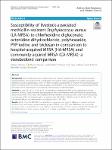Susceptibility of livestock-associated methicillin-resistant Staphylococcus aureus (LA-MRSA) to chlorhexidine digluconate, octenidine dihydrochloride, polyhexanide, PVP-iodine and triclosan in comparison to hospital-acquired MRSA (HA-MRSA) and community-aquired MRSA (CA-MRSA): a standardized comparison
Dittmann, Kathleen
Schmidt, Thomas
Müller, Gerald
Cuny, Christiane
Holtfreter, Silva
Troitzsch, Daniel
Pfaff, Peter
Hübner, Nils-Olaf
Background
Recent publications have raised concerns of reduced susceptibilities of clinical bacterial isolates towards biocides. This study presents a comparative investigation of the susceptibility of livestock-associated Methicillin-resistant Staphylococcus aureus (LA-MRSA), hospital-acquired MRSA (HA-MRSA) and community-aquired MRSA (CA-MRSA) to the commonly used antiseptics chlorhexidine (CHX), octenidine (OCT), polyhexanide (PHMB), PVP-iodine (PVP-I) and triclosan (TCX) based on internationally accepted standards.
Methods
In total, 28 (18 LA-, 5 HA- and 5 CA) genetically characterized MRSA strains representing a broad spectrum of hosts, clonal complexes and spa-types, as well as the reference methicillin-sensitive Staphylococcus aureus (MSSA) strain ATCC 6538, were selected. Minimal inhibitory concentration (MIC) and minimal microbicidal concentration (MBC) were determined in accordance with DIN 58940–7, 58940–8 and DIN EN ISO 20776-1. The microbicidal efficacy was determined in accordance with DIN EN 1040.
Results
Results from the MIC/MBC and quantitative suspension tests revealed differences between antiseptic substances but not between epidemiological groups of MRSA strains. OCT and PHMB were the most active substances with a minimal MIC of 1 mg/L, followed by CHX (2 mg/L), TCX (32 mg/L) and finally PVP-I (1024 mg/L). The MSSA reference strain showed a tendency to a higher susceptibility compared to the MRSA strains.
Conclusions
This investigation of the susceptibility of a range of LA-, HA- and CA-MRSA strains using standardized conditions gave no indication that LA-MRSA strains are less susceptible to commonly used antiseptics compared to HA- and CA-MRSA strains.
Dateien zu dieser Publikation

